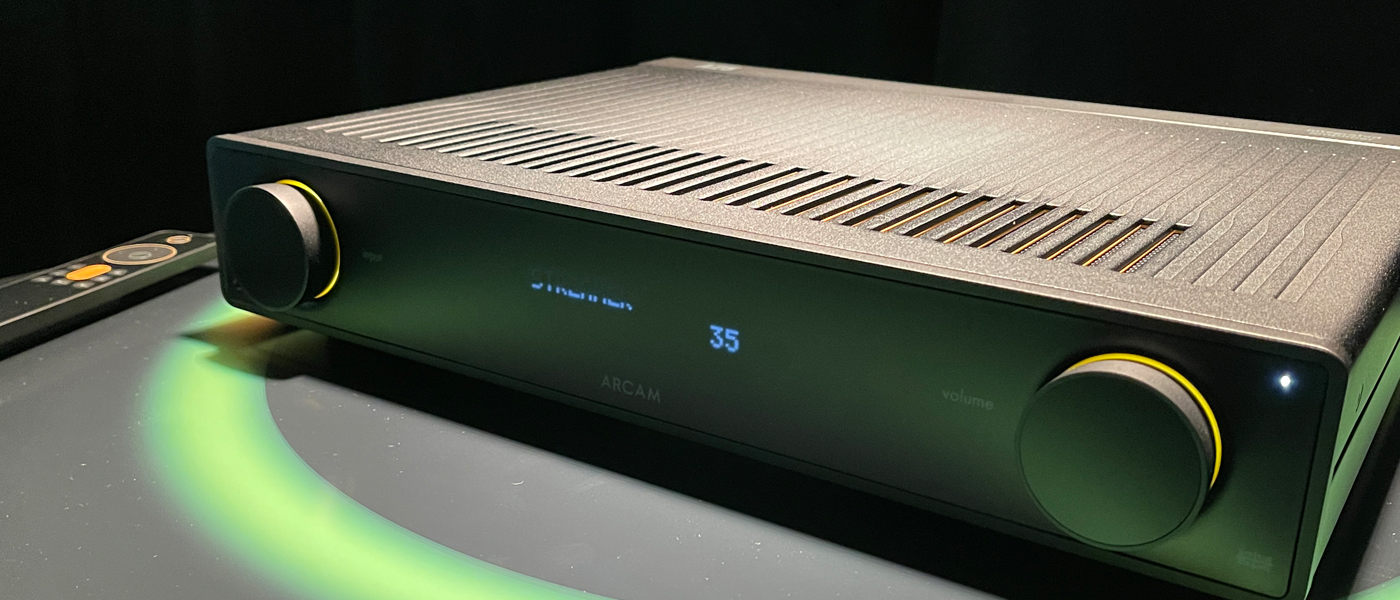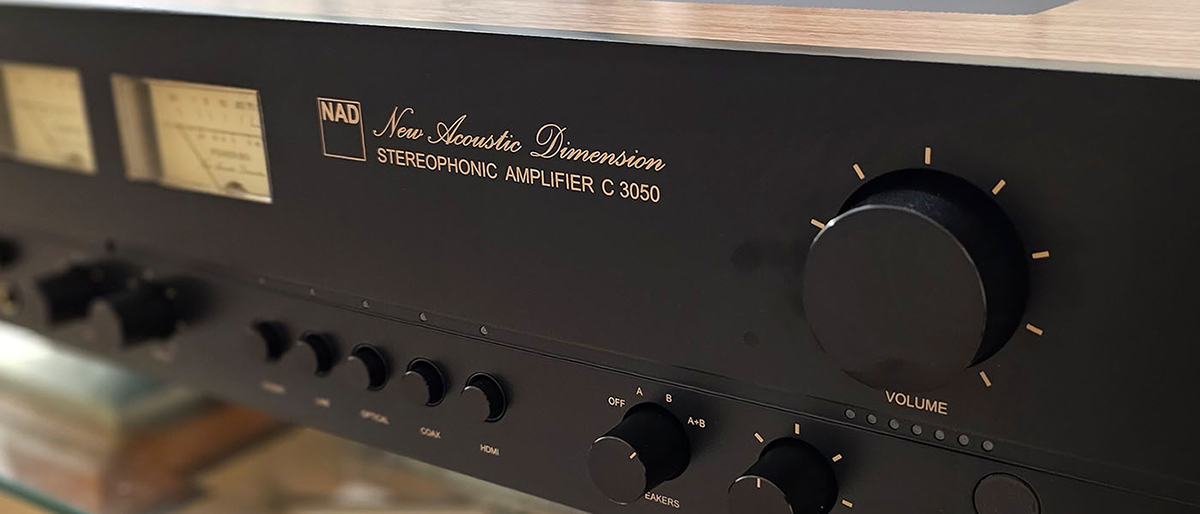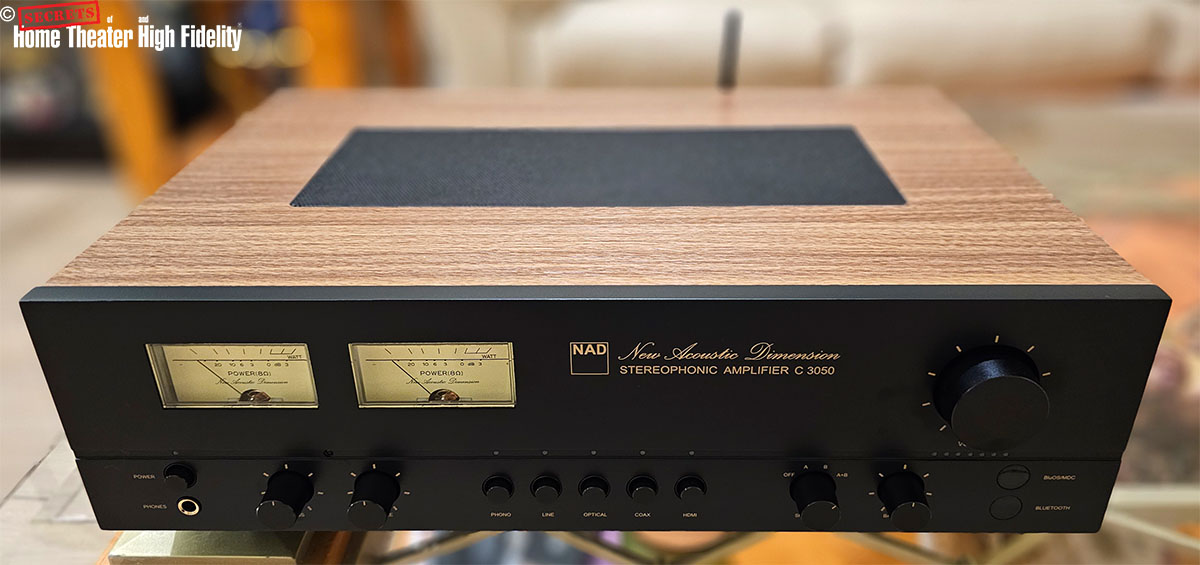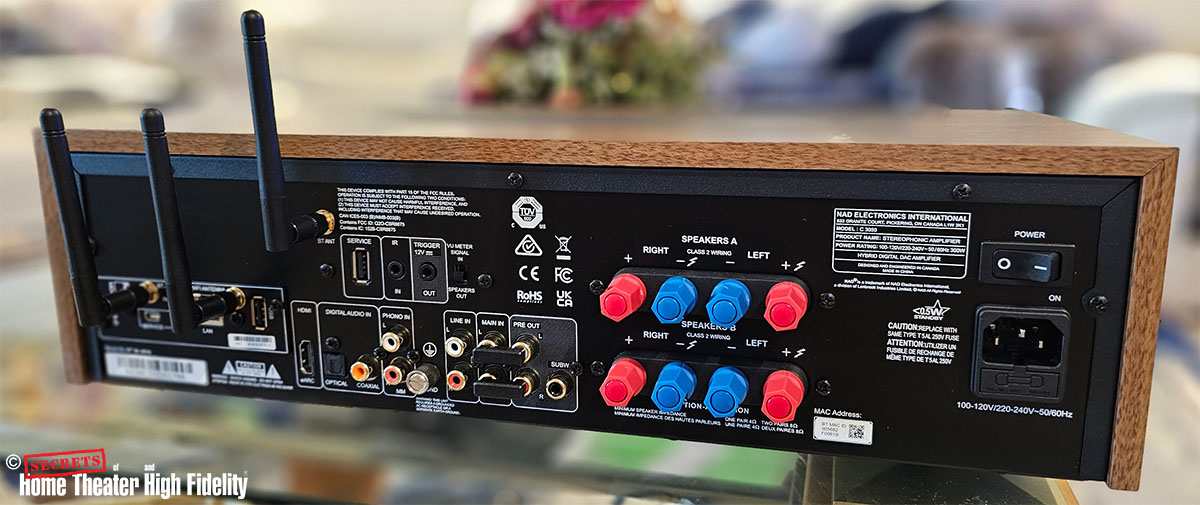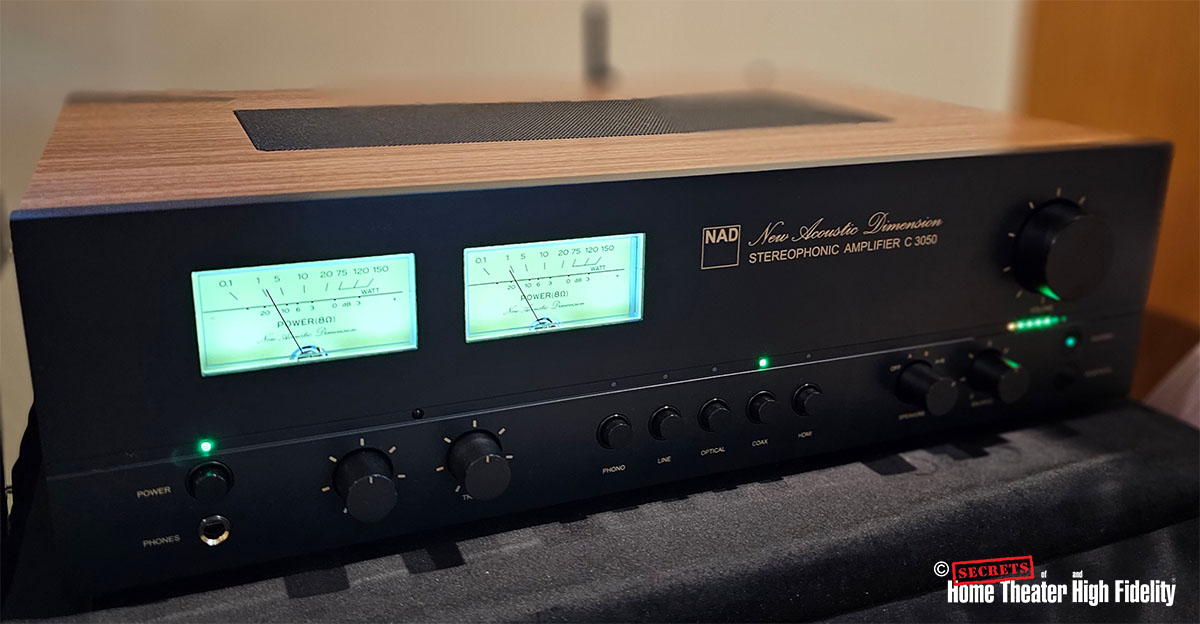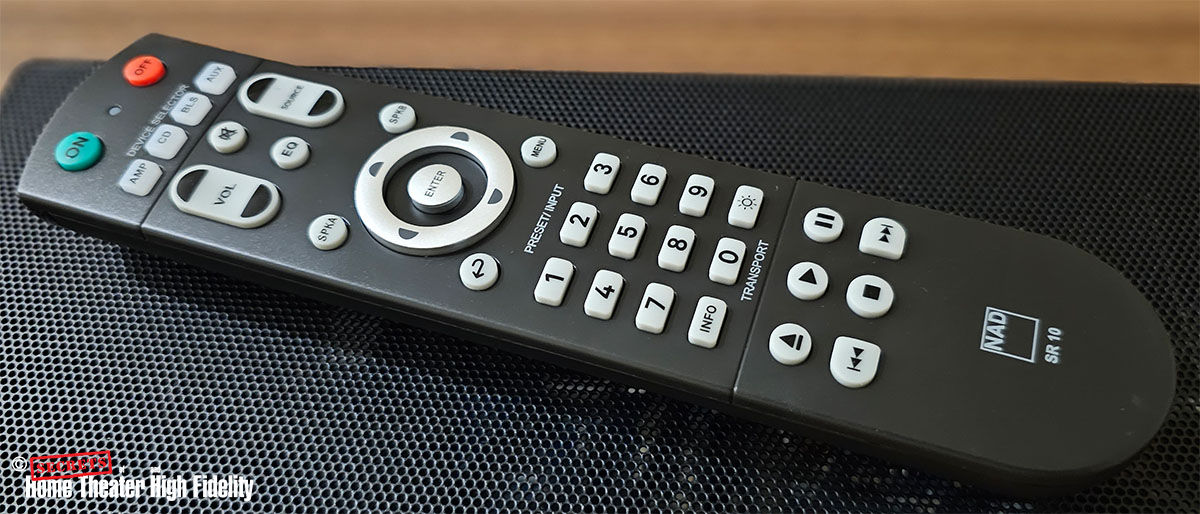Even though the C 3050 integrated amplifier employs retro design elements, which include dual VU meters, push-button input selectors, a walnut-finished vinyl-clad cabinet, and a dark grey front panel with the original 1970s cursive New Acoustic Dimension logo, it is a modern amplifier through and through. Underneath its vintage-inspired exterior are advanced features allowing the C 3050 to process analog and digital signals. The amplifier is also equipped with NAD’s Modular Design Construction 2 (MDC2) future-proofing technology, which allows the addition of new capabilities into the unit by simply inserting an optional module into the MDC2 expansion slot.
NAD C 3050 Stereophonic Amplifier Highlights
- Modern integrated amplifier with vintage vibes.
- Feature-expandability through modular design technology.
- Capability of playback of high-resolution PCM (up to 24-bit/192-kHz) and MQA-encoded music files (through its optional BluOS streaming feature).
- Wireless connectivity and app control feature.
- Solid build quality.
- Competent all-around performer.
The nostalgic audiophile crowd should be happy with the recent efforts of some audio manufacturers to bring back vintage design elements into their products, mostly as a tribute to their history. I may not be one from this crowd, as I started to enter the serious phase of this hobby only in the 1990s, but I can appreciate the appeal of such vintage-inspired designs. I believe, so do many of the younger audiophiles, such designs are usually for the consumption of the eyes. The products themselves are still equipped with modern technologies and features to cater to the demand of today’s audiophile crowd.
Such is the case with the NAD C 3050 Stereophonic Integrated Amplifier reviewed here. The C 3050 revives NAD’s vintage look to commemorate the company’s 50-year history of innovation. Intended to be a feast for the eyes and ears, NAD complements the C 3050’s vintage-inspired design with the company’s technological innovation to achieve performance worthy of current standards.
PREAMPLIFIER SECTION
LINE INPUT, PRE-OUT
THD+N (20 Hz – 20 kHz):
<0.005 % at 2V out
Signal-to-Noise Ratio:
>95 dB (A-weighted, ref. 500 mV out, unity gain)
Channel separation:
>100 dB (1 kHz), >90 dB (10 kHz)
Input impedance (R and C):
28 kohms + 360 pF
Maximum input signal:
>4.5 Vrms (ref. 0.1 % THD)
Output impedance:
440 ohms
Maximum voltage output -IHF load:
>2 V (ref. 0.1 % THD)
Frequency response:
±0.3 dB (20 Hz – 20 kHz)
PHONO INPUT, PRE-OUT
THD+N (20 Hz – 20 kHz):
<0.03% at 2 V out
Signal-to-Noise Ratio:
>79 dB (200 ohms source; A-weighted, ref. 500 mV out)
Input impedance (R and C):
46 kohms/100 pF
Maximum input signal:
>4.5 Vrms (ref. 0.1 % THD
Frequency response:
±0.3 dB (20 Hz – 20 kHz)
Maximum input signal at 1kHz:
>80 mVrms (ref. 0.1 % THD)
LINE INPUT, HEADPHONE OUT
THD (20 Hz – 20 kHz):
<0.005% at 1V out
Signal-to-Noise Ratio:
>96 dB (32 ohms loads; A-WTD, ref. 2 V out, unity gain)
Channel separation:
>60 dB at 1kHz
Output impedance:
2.2 ohms
Frequency response:
±0.3 dB (20 Hz – 20 kHz)
MAIN IN, SPEAKER OUT
Continuous output power into 8 ohms and 4 ohms:
100 W (20 Hz-20 kHz at rated THD, both channels driven)
THD (20 Hz – 20 kHz):
<0.03% (250 mW to 100 W, 8 ohms and 4 ohms)
Signal-to-Noise Ratio:
>95dB (A-weighted, 500 mV input, ref. 1 W out in 8 ohms)
Clipping power:
>115 W (at 1 kHz 0.1 % THD)
IHF dynamic power:
8 ohms: 180 W, 4 ohms: 250 W, 2 ohms: 300 W
Frequency response:
±0.3 dB (20 Hz – 20 kHz)
Channel separation:
>75dB (1 kHz), >70dB (10 kHz)
CONNECTIVITY
Bluetooth connectivity:
One-Way
Bluetooth quality:
aptX HD 5.0
BluOS Connectivity (with the optional MDC2 BluOS-D module):
Supported audio file format:
MP3, AAC, WMA, OGG, WMA-L, ALAC, OPUS
Supported high-resolution format:
FLAC, MQA, WAV, AIFF
Sampling rate:
up to 192 kHz
Bit depths:
16 – 24
Supported services:
Qobuz, Tidal, Deezer, Spotify, Amazon Music, Internet Radio, etc.
Voice Control:
Amazon Alexa and Apple’s Siri
Network connectivity:
Gigabit Ethernet RJ45, Wi-Fi 5
USB:
1 x Type-A port for connection to USB storage media (FAT32 or NTFS formatted)
Bluetooth connectivity:
Two-Way (Receive and Headphone modes), aptX HD 5.0
Mobile Application
BluOS Controller App (iOS, Android, Kindle Fire, and Windows versions)
GENERAL SPECIFICATIONS
Inputs available:
Analog: 1 x Line In, 1 x Phono In, 1 x Main In;
Digital: 1 x Coax, 1 x Optical, 1 x HDMI eARC
Outputs:
Speakers A + B, 1 x subwoofer out, 1 x Pre Out
Power consumption at Auto Standby ON:
0.5 W
Gross dimensions (W x H x D):
17 5/8 x 5 x 13 3/16 inches (447 x 127 x 335mm)
Net weight:
22 lbs (10 kg)
Website:
MSRP:
$1,399 without the BluOS-D module
$1,799 with the BluOS-D streaming module
Company:
SECRETS Tags:
NAD, C 3050, Stereophonic Amplifier, Integrated Amplifiers, Vintage-inspired design, Modular Design Technology, Modular Design Construction 2 (MDC2), Future-proofing technology, Wireless connectivity
Just a quick glance at the C 3050 is all it takes to get the vintage vibe from it. NAD seems to go all out in applying the vintage elements to the C 3050 design, which includes dual VU meters, push-button input selectors, walnut-finished vinyl-clad cabinet, and 1970s cursive-style branding. Without looking at the back of the unit, I would not have a clue that it is a 21st-century audio component. Although beauty is in the eye of the beholder, to me the C 3050’s two-tone matte black faceplate and walnut-finished cabinet sports a charming classic appearance that is very appealing.
The front panel of the C 3050 looks clean and uncluttered. On the upper part of the front panel, the NAD branding is flanked by the volume-control rotary knob and the dual rectangular VU meters. These VU meters, which can be set to monitor the input signal or the amplifier output levels by a switch on the rear panel, are lighted when the unit is in operation. Although in normal operation one rarely makes use of the VU meters, it is always cool to see the dancing needles when the unit is in operation. Located on the lower part of the front panel are the on/standby button, a headphone jack, treble/bass/balance rotary knobs, rotary speaker selector, and input selector push buttons. Above each input button, there is a small LED light that illuminates when the input is active. Below the volume knob, there is a row of LEDs that serves as the volume-level indicator. The number of illuminated LEDs in the indicator increases or decreases as the volume level is increased or decreased. The input and volume-level LED indicators can be dimmed or turned off completely by toggling a specific button on the remote control. There are 6 levels of brightness for these LED indicators, but I found that the brightness range was overly narrow. I would prefer to have the difference between the maximum and minimum brightness be more obvious. Currently, at their lowest dim level, these LEDs were still too bright for my taste. The VU meters’ lights are not adjustable, and they are always lighted when the unit is on.
The vintage-inspired exterior look of the C 3050 hides the thoroughly modern technological features of the unit. The ability to handle digital signals on top of the usual analog signals and Bluetooth control/streaming capabilities are some of the technological differentiators between the C 3050 and an actual vintage product. The C 3050’s digital section employs Texas Instruments PCM5242 high-resolution differential DAC, which can process up to 32-bit/384-kHz PCM-type digital signals. The digital signal processing on the amplifier is, however, limited to 24-bit/192-kHz. The power amplifier stage in the C 3050 utilizes HybridDigital UcD Class-D technology capable of producing continuous 100 W per channel into 8 or 4 ohms with both channels driven. Dynamically, it can produce instantaneous power of 180 W into 8 ohms, 250 W into 4 ohms, or 300 W into 2 ohms. Hence, as far as the amplifier goes, the C 3050 is deceivingly more powerful than its size might suggest.
The C 3050 is also equipped with the latest NAD’s Modular Design Construction 2 (MDC2) technology, which allows the addition of features to the base unit by inserting an add-on module into the MDC2 slot on the back panel, making the product somewhat future friendly. According to NAD, the MDC2 is an all-new design that enables two-way communication between the expansion module and the host component. The review unit comes with the optional MDC2 BluOS-D module, which adds high-resolution streaming capability and a Dirac Live room correction feature to the base C 3050. The module is also equipped with bidirectional Qualcomm aptX HD Bluetooth wireless technology, which allows for Bluetooth music streaming and sending music to Bluetooth headphones/earphones. In my opinion, this addition is well worth its cost of $400 (MSRP of the C 3050 is $1,399 without the BluOS-D module and $1,799 with the BluOS-D streaming module), especially if streaming is your main source of music. The module comes with dual antennae (for Wi-Fi and Bluetooth) as well as the calibration microphone for the Dirac Live feature. With this module installed, the Bluetooth feature and antenna on the base unit become redundant.
The MDC2 BluOS-D module features dual-band Wi-Fi/Gigabit Ethernet and provides access to local music servers (such as a NAS on the same network) as well as to more than 20 streaming services, including high-resolution and lossless streaming providers such as Qobuz, Tidal, Deezer, and Amazon. Besides supporting high-resolution PCM audio up to 24-bit/192-kHz, BluOS is also capable of decoding and rendering MQA music files. Native DSD playback is not supported, however, BluOS offers a one-time conversion of DSD to FLAC PCM methodology (step-by-step instructions are available from the BluOS support site) that can be used to play DSD files. The module also supports Spotify Connect, Tidal Connect, and Apple AirPlay 2. It also allows integration to Amazon Alexa or Apple Siri for playback using voice control. The MDC2 module also features bidirectional architecture, hence it can be networked as part of a whole-home music system with other BluOS-enabled components in other rooms. BluOS comes with its own freely downloadable Android or iOS control app. Besides serving as the integrated hub for all the supported streaming services, the app can be used to control the host component, such as input selection, volume level adjustment, and the pre/sub-out modes.
A quick glance at the rear panel of the C 3050 reveals its extensive connectivity. On the analog side, it has a set of line-level and a set of MM phono inputs. On the digital side, it provides a coaxial, an optical, and a HDMI eARC input connections. The provision of the HDMI eARC input allows the C 3050 to handle TV sound. On the installed MDC2 BluOS-D module, there is also a USB port for connecting to an external drive. The C 3050 supports two sets of five-way binding-post type speaker terminals, labeled Speakers A and Speakers B. These terminals can be activated individually or both or completely deactivated using the speaker selector on the front panel or using the supplied remote control. A set of pre-out and a subwoofer out are also available. The unit is shipped with the pre-out linked to the main-in inputs. The provision of the pre-out and main-in connectors on the rear panel means that C 3050 can function as a standalone preamp to be used with an external amplifier and/or serve as a power amplifier to be connected with an outboard preamp. It can also accommodate an external intermediate component, such as a processor or equalizer, to process the line-level output of the C 3050 before sending it back the processed signals to its amplifier stage. By default, the outputs of the pre and subwoofer-out signals are full range. However, with the BluOS module installed, the crossover frequency between the pre and subwoofer outs can be adjusted through the BluOS app.
The C 3050 is supplied with a medium-sized plastic infrared remote control, which can be used to switch on/standby the device, select the input, adjust the volume level or mute the sound, select the active speakers, and dim/un-dim the LED display. It can be used to control up to 4 NAD devices through the 4 device-selector buttons on the top part of the remote layout. These device-selector buttons are backlit, and the selected active device button will light up with the press of any button on the remote. The MDC2 BluOS-D module is one of the devices selectable (labeled BLS). In the BLS mode, the playback control button set can be used to control the BluOS playback operation (play/pause and skip forward/backward). The remote buttons are of good sizes and comfortable to use, however, I used more often the BluOS app for the day-to-day operation of the unit.
Secrets Sponsor
Just like any modern integrated amplifier with streaming capability, the C 3050 can be an operational music system by simply plugging it into the electricity source, connecting the BluOS module to the home network (wired or Wi-Fi), and connecting it to a pair of speakers. That is how the C 3050 was mostly utilized during the review. Connecting the amplifier to my home network was relatively easy with the help of the BluOS app. Just tap the Player Drawer (House icon) on the upper right corner of the app and select ‘Add a Player’ to begin detection of the compatible players in the network. When I performed this step, the app immediately detected the C 3050 as the compatible player in the network with no issue. Following that, the app provided me with step-by-step instructions to connect the amplifier to my Wi-Fi network. Once the connection had been established, I set up my music library by logging in to my Qobuz and Tidal accounts through the app, which then allowed me to start streaming music through the C 3050.
Other sources used in this evaluation were the AURALiC Aries G1 streamer and the PS Audio PerfectWave Transport. Besides serving as digital sources, these devices, in conjunction with the PS Audio DirectStream DAC, were used as an analog line-level input source to the C 3050. Finally, the Music Hall Classic turntable was used as the source for the MM phono input of the amplifier. The amplifier was paired with my Revel Ultima Studio speakers during the review. I also summoned my Rythmik F12SE subwoofer in part of my evaluation to assess the C 3050’s sub-out feature.
To utilize the Dirac Live feature that came with the MDC2 BluOS-D module, additional setup work was needed, which involved installing the Dirac Live app on my iPad and connecting the included calibration microphone with its adapter to the USB-A port of the MDC2 module. The Dirac Live app provided a guide to the calibration process, which was quite easy to follow. This involved placing the microphone in various specified positions while the Dirac Live app performed the test-tone measurements. It should be noted that the Dirac Live feature included with the amplifier is to provide room compensation in the below 500 Hz range, so mostly this feature is to optimize the bass response, which is often problematic in most rooms. Once the Dirac Live calibration had been completed and the result had been saved, an on/off switch to activate the Dirac filter appeared in the Audio Settings menu in the BluOS app. Interestingly, the MDC2’s two-way communications allow the Dirac Live compensation to affect any source connected to the C 3050, not just the sources/inputs directly related to the BluOS-D module.
Engaging the Dirac filter eliminated the bass peaks due to room modes and as a result generated more uniform bass responses. This feature would be extremely useful if you have problematic bass modes in your listening room. With my setup, the use of the Dirac filter yielded mixed impressions. On the one hand, I could sense the more uniform low-frequency response, but on the other hand, I felt that it took away some of the bass slams from the music. For this reason, I did not always like the results with the Dirac filter engaged. I guess your preference might depend on your taste and your room acoustics situation. For this review, since this feature is optional, I will describe my sound impression of the C 3050 without the Dirac filter engaged.
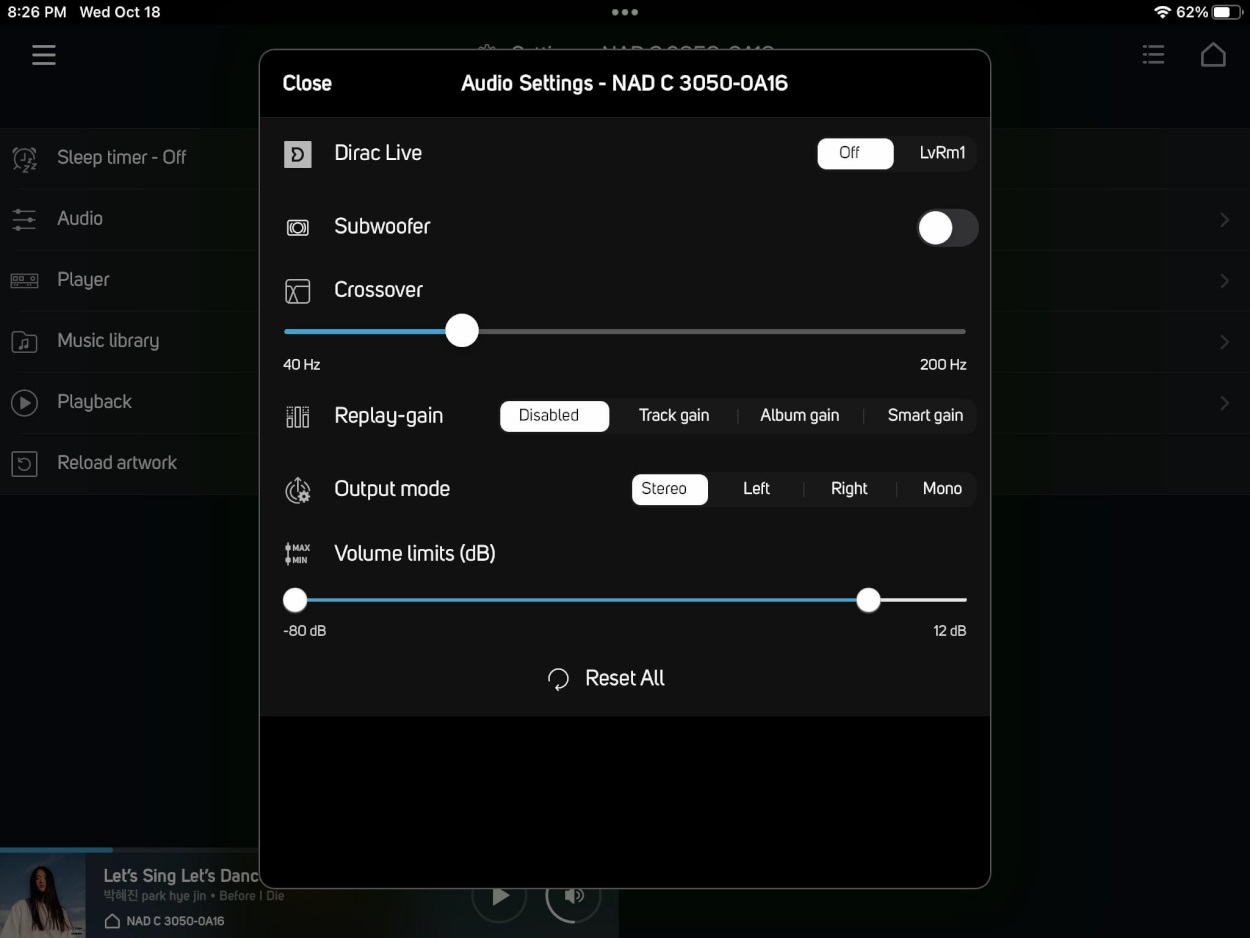 BluOS app screenshot showing C 3050 device control
BluOS app screenshot showing C 3050 device control
I reviewed and owned NAD equipment before, so I approached the C 3050 with some latent expectations. Typical to my experience with NAD products, the C 3050 did not disappoint. The C 3050 is a solid performer across its range of functionalities. It handled any analog or digital signal I threw at it with great conviction. With any source, the C 3050 never failed to produce clear and detailed sound with good overall sonic balance across the frequency spectrum. The fullness of the sonic presentation was unmistakable with no noticeable hole or emphasis on any given frequency range. The C 3050 was quite adept too in imaging and decoding the spatial information in the recordings, resulting in focused images and satisfactory soundstage presentations. The sonic attributes described above also held true for vinyl playback through the C 3050’s MM phono feature, which was to say that its phono performance was good. Although I had heard better phono playback performance from an integrated amplifier, nevertheless the level of phono playback performance that the C 3050 exhibited was satisfactory.
The C 3050’s onboard DAC showed adeptness in decoding the digital signal inputs within its specifications. During the review, I sent various high-resolution as well as MQA-encoded signals from the AURALiC Aries G1 streamer to the coaxial digital input of the C 3050 and never experienced glitches/issues. One of these high-resolution tracks was Left Alone (24-bit/96-kHz format from Qobuz) from the late Jimmy Heath’s Love Letter (2020) album, which sounded glorious with its full texture and details through the C 3050. Cecile McLorin Salvant’s mellow voice in the track sounded natural and full-bodied. The cymbals in the background sounded realistic and sufficiently detailed. The image portrayal was relatively neutral (not forward or too laid-back) and the soundstage depiction was sufficiently spot-on. The sonic balance was neutral with ever a slight tilt towards brightness. This should not be a cause for concern, however, as it did not cause listening fatigue and in any way, it added a bit of sparkle that avoided dull musical presentations. The C 3050’s onboard amplifier exhibited sufficient power for its intended application. It maintained its composure well even when driven hard for playback at relatively high volume levels.
I spent a great deal of time on the C 3050’s BluOS streaming feature during this evaluation. In my opinion, the BluOS app has a great user interface, and it is a delight to use. Its streaming playback control features were quite comprehensive and displayed sufficient metadata of the track and album being played. The app was quite nimble too in handling the control tasks. The slight delay from the time a song was selected in the app until it started being played back through the C 3050 was not at all objectionable.
The sonic quality of the streaming playback through the C 3050 was overall respectable. Music sounded well balanced across the audio bands with sufficient clarity, transparency, and details. The streamer in the C 3050 in general portrayed a slightly forward center image leading to an intimate presentation. The soundstage projection was good, although typically not as deep as what I got from the Aries G1 streamer. I also noticed a slight lack of midrange smoothness and treble airiness in comparison with the presentation from the Aries G1 streamer through the C 3050’s DAC. But in perspective, the significant price difference between the two products makes this comparison unfair. Overall, the C 3050’s streamer held its ground well as compared to the stand-alone Aries G1. Moreover, the streaming performance of the C 3050 delivered sufficient musicality that was more than made up for its weaknesses.
The title track of the Bewitched album by the Icelandic jazz singer, Laufey, sounded particularly lively and intimate when streamed through the C 3050. Laufey’s mesmerizing voice in the track sounded natural and projected slightly forward, hence the more intimate impression. The orchestral assembly accompanying Laufey was conveyed with sufficient width and depth. The whole presentation was musically engaging, allowing my emotions to sway with the melodies. The musicality of the C 3050 was further exemplified by the track From the Start from the same album, which clearly exhibited the C 3050’s competence in conveying rhythm and pace in the music. The bass rhythm in the track was presented with good impact and tunefulness that made me toe-tap along with the music.
I found that the bass response of the C 3050 driving the Revel Ultima Studio in a full-range fashion (the ‘Subwoofer’ setting was set to off) was satisfactory for most applications. On music with deep bass content in the background, however, sometimes I felt the bass definition could use some improvement. This situation could easily be remedied by adding a good subwoofer in the mix and switching on the ‘Subwoofer’ setting in the app, essentially running a 2.1 configuration. Inserting my Rythmik F12SE subwoofer in such a configuration (with crossover at 50 Hz) improved the overall bass definitions of the presentation.
Finally, I like the provision of the wireless Bluetooth headphone connectivity on the C 3050. It adds a degree of versatility to the feature-laden C 3050. From my brief tryout using the Sony WH-1000XM4 headphones, the wireless Bluetooth headphone connection delivered about the same level of performance as its wired connection through the headphone jack. The clarity, details, and well-balanced nature of its headphone sonic performance were satisfactory.
Secrets Sponsor
Versatility and solid sonic performance at a price point that does not break the bank seem to be the formula of success for this retro-looking NAD C 3050.
- Handsome retro look.
- Feature expandability by card insertion.
- Handles both analog and digital signals.
- Optional MDC2 BluOS-D addition which adds BluOS streaming and Dirac Live room correction features.
- Competent all-around performer.
- Native DSD processing capability.
- Additional digital input (USB?).
Sporting a retro appearance, the NAD C 3050 is a versatile, modern integrated amplifier that performs admirably in all its functionality. Moreover, its modular design allows for the addition of features by a simple module card insertion. The review sample has the MDC2 BluOS-D module that adds BluOS streaming and Dirac Live room correction features, which further enhance the versatility of the C 3050. More importantly, this versatility is backed up by its solid sonic performance, creating a combination that is hard to beat at its price point.


